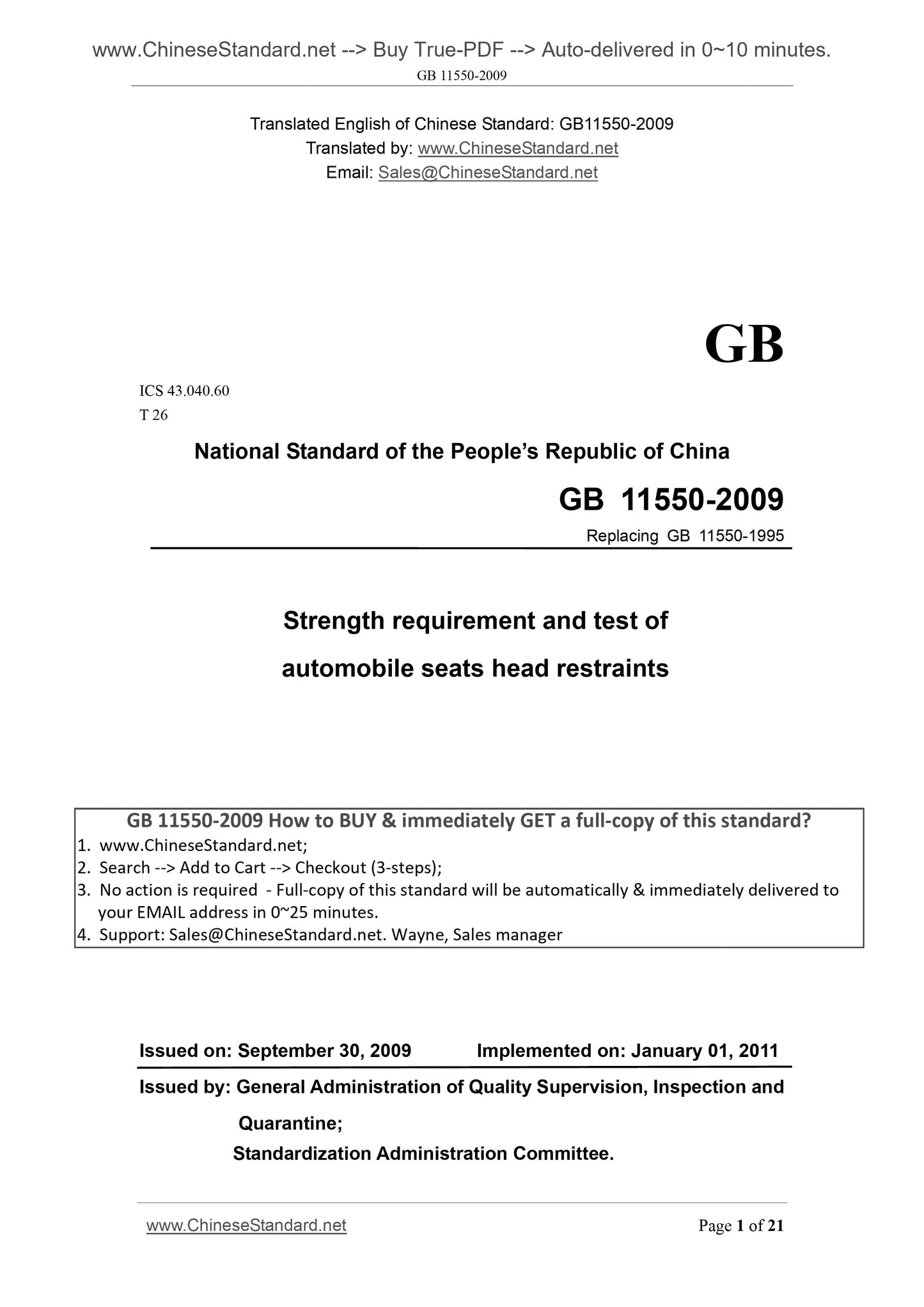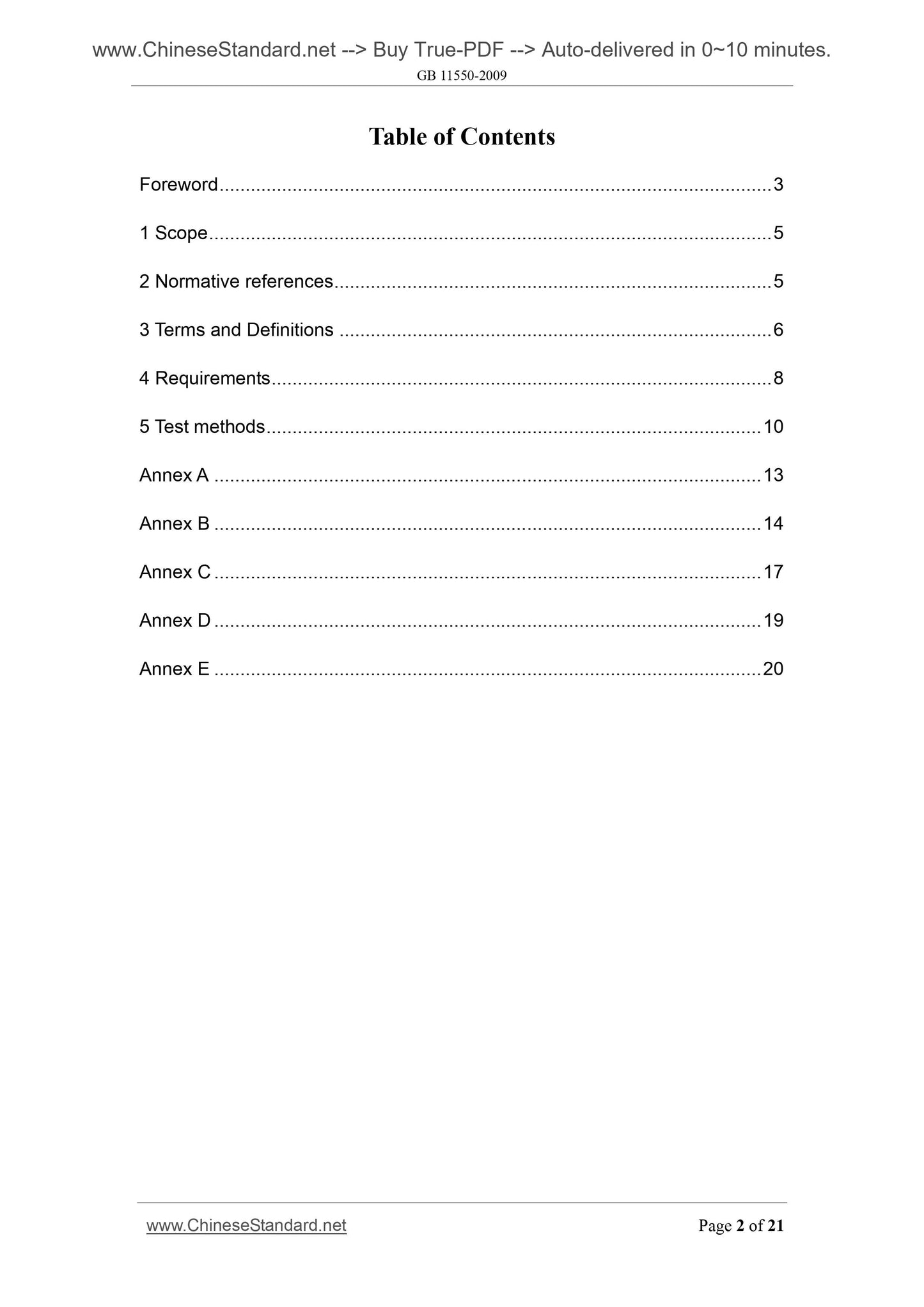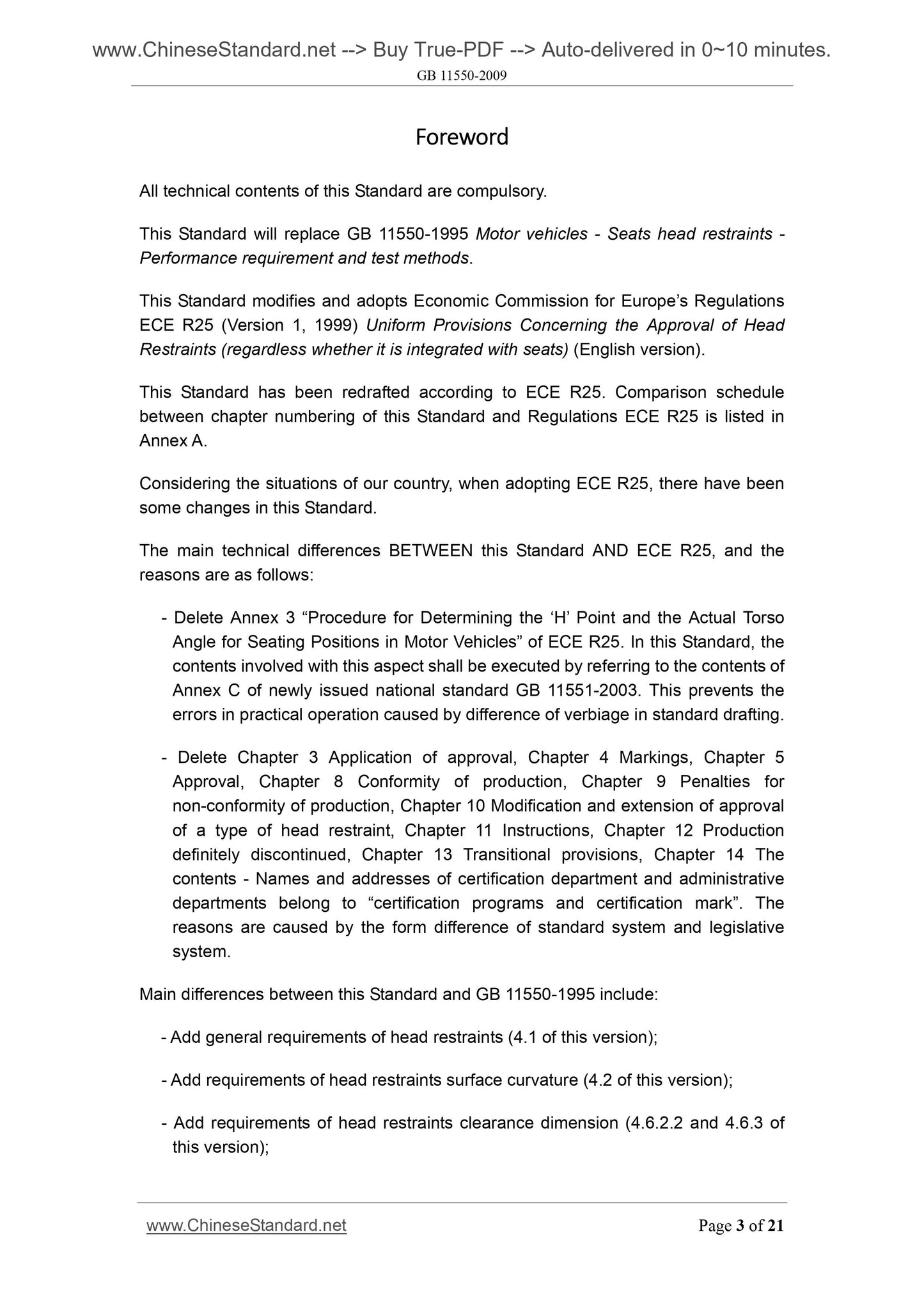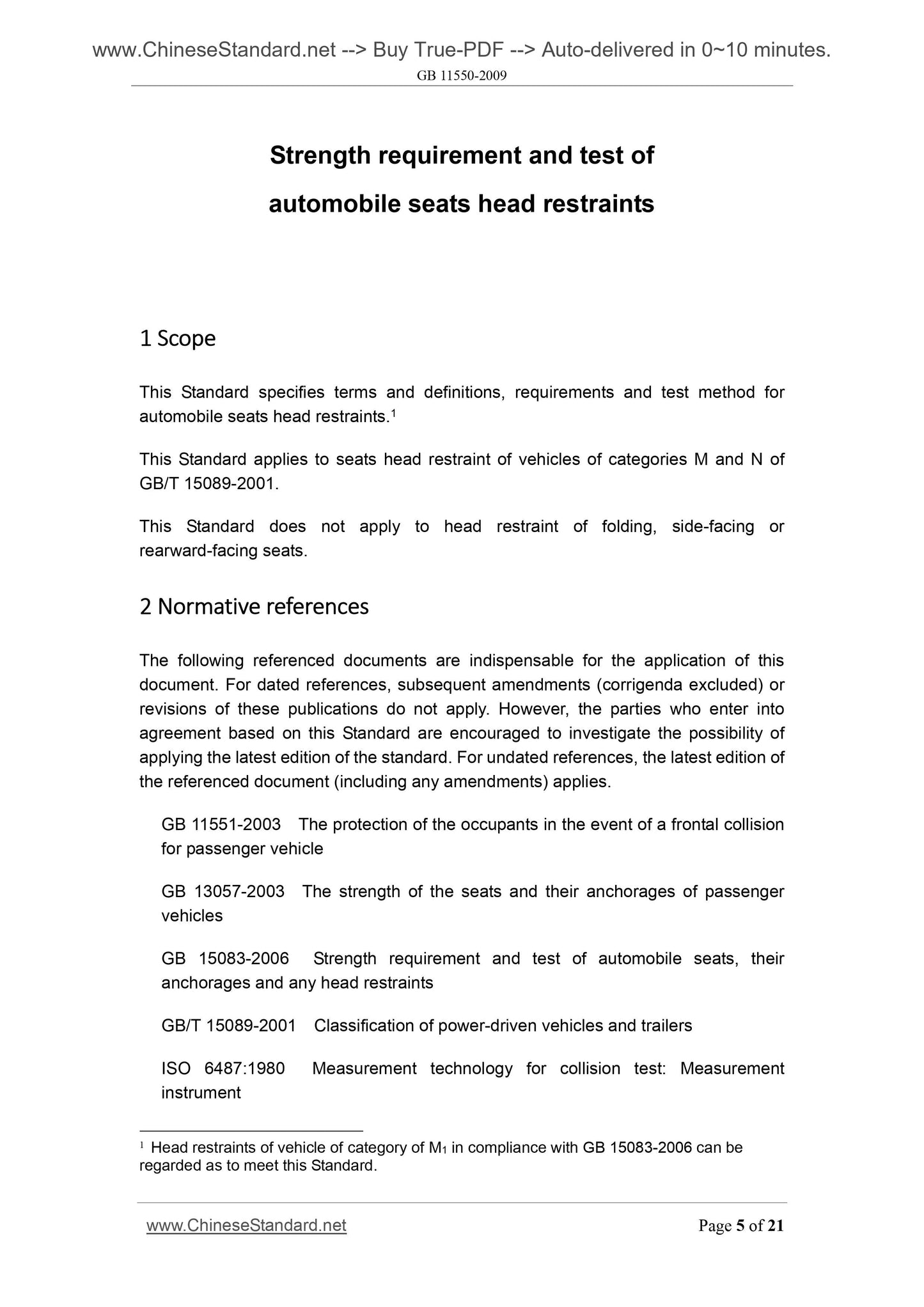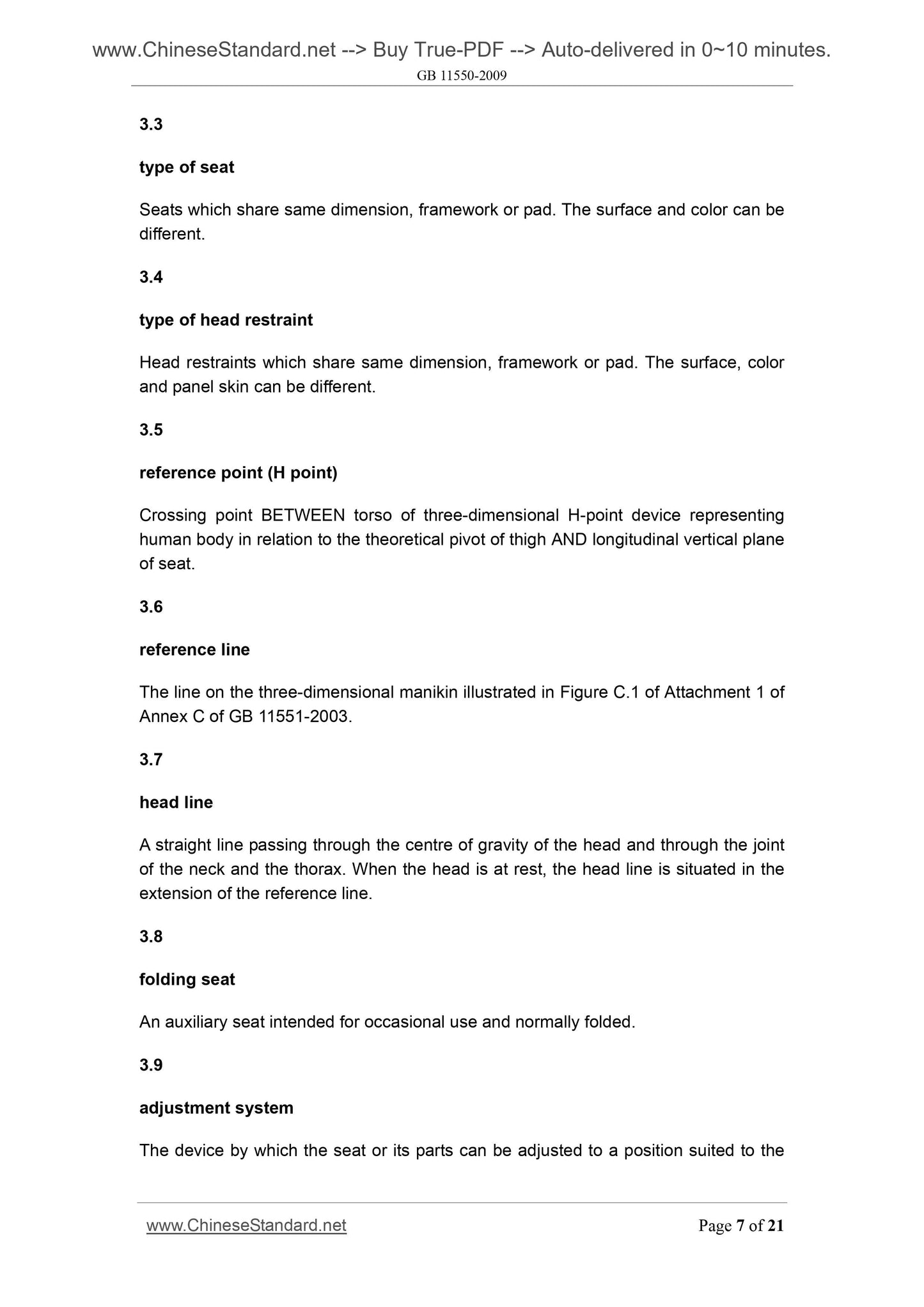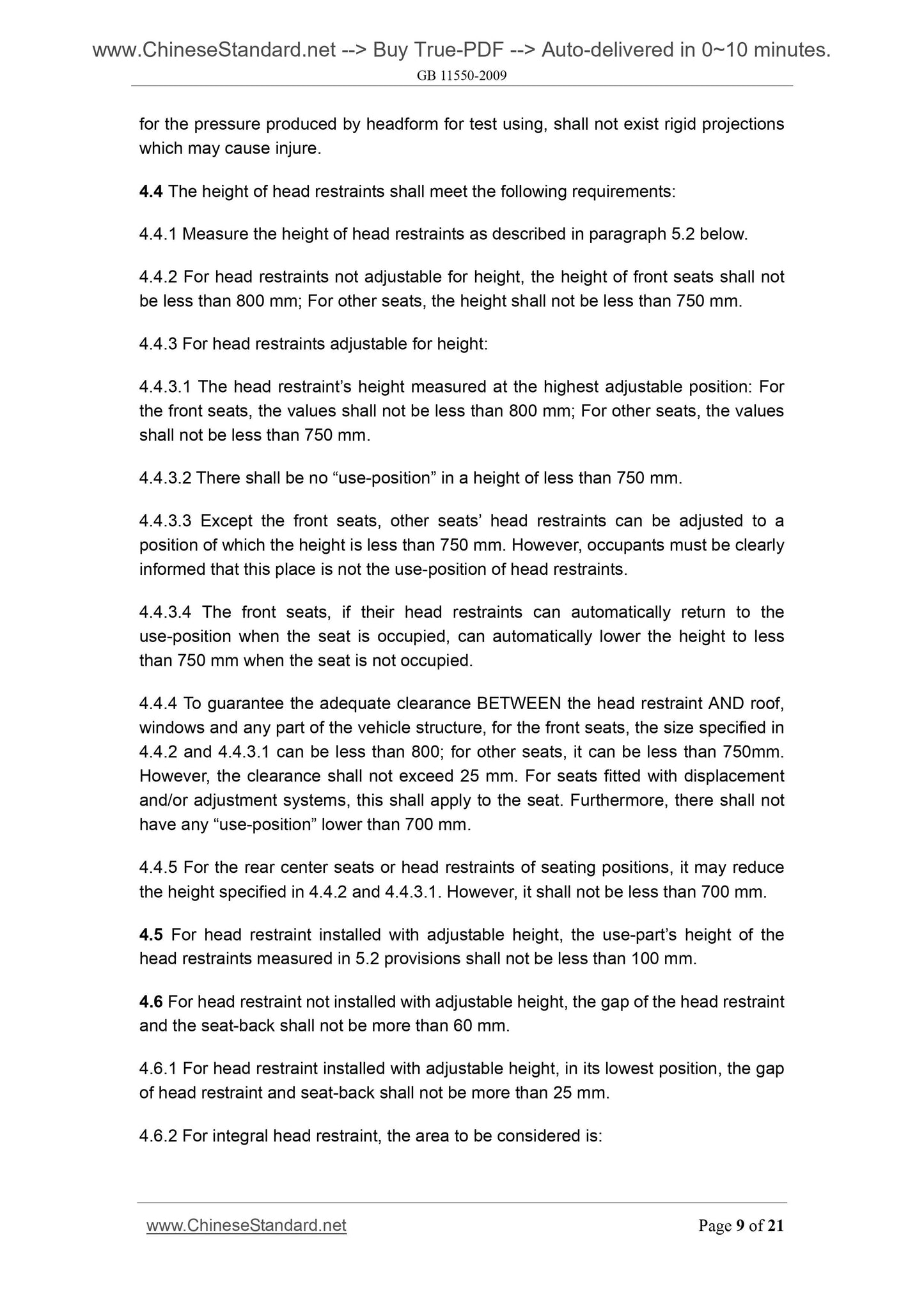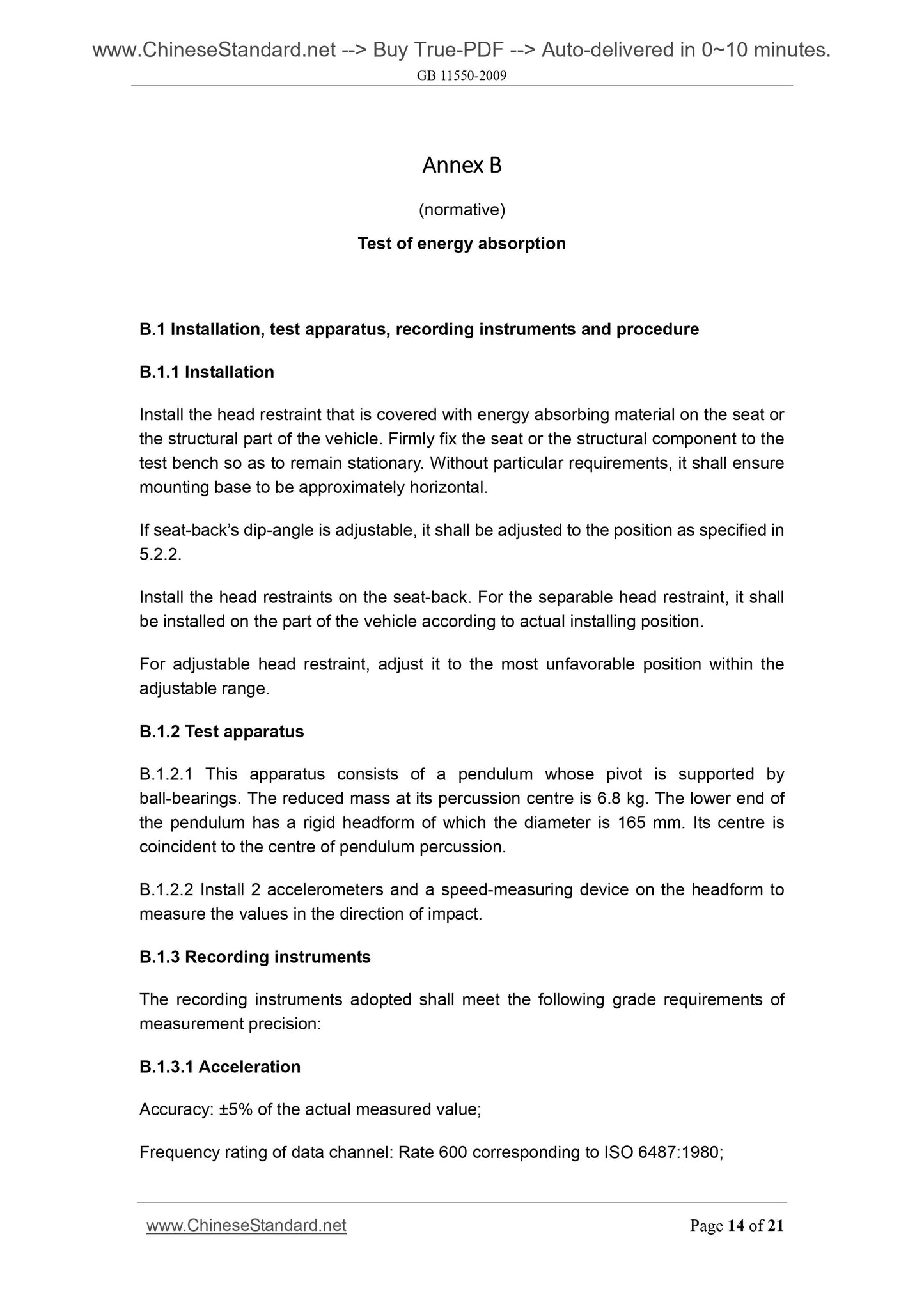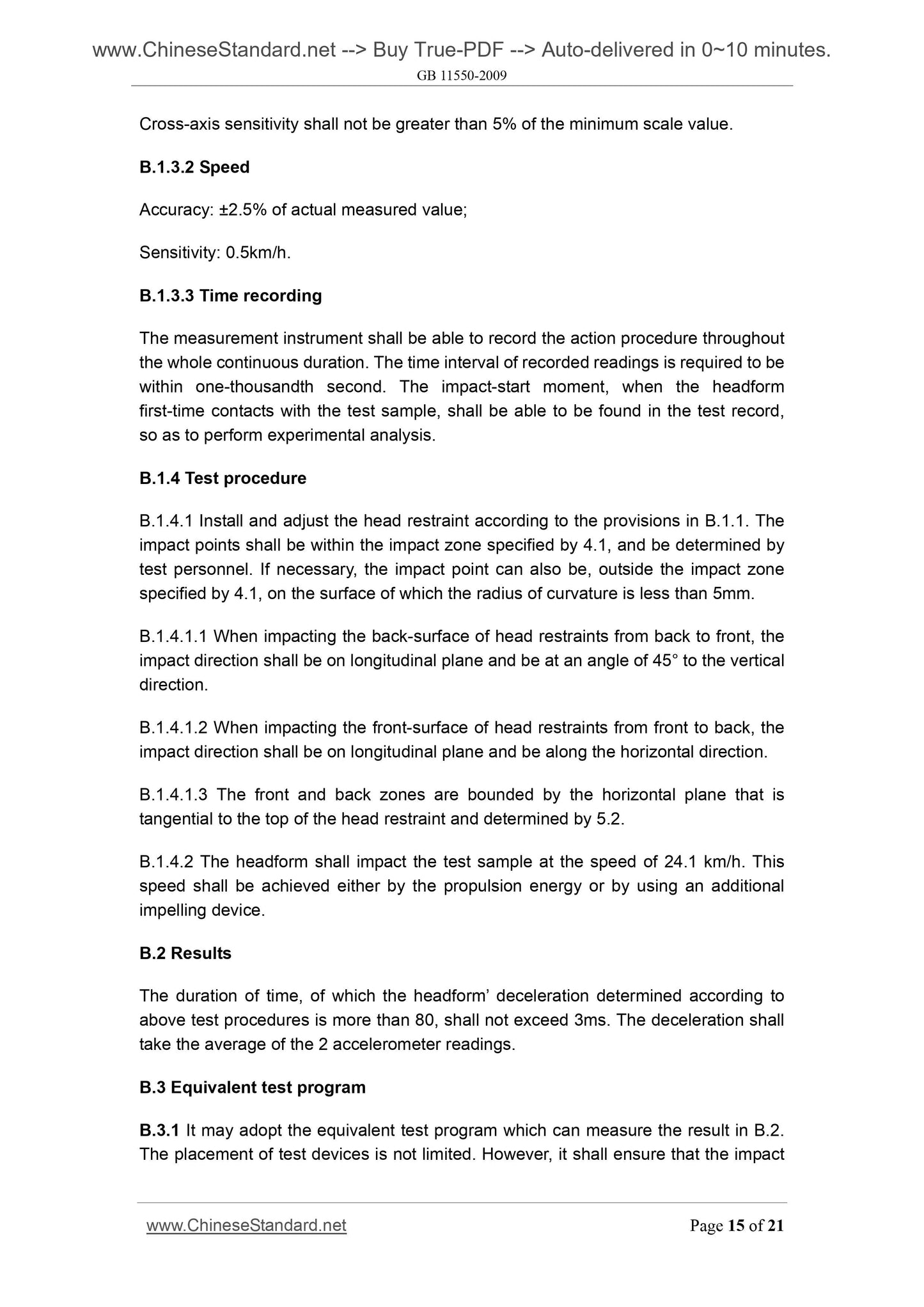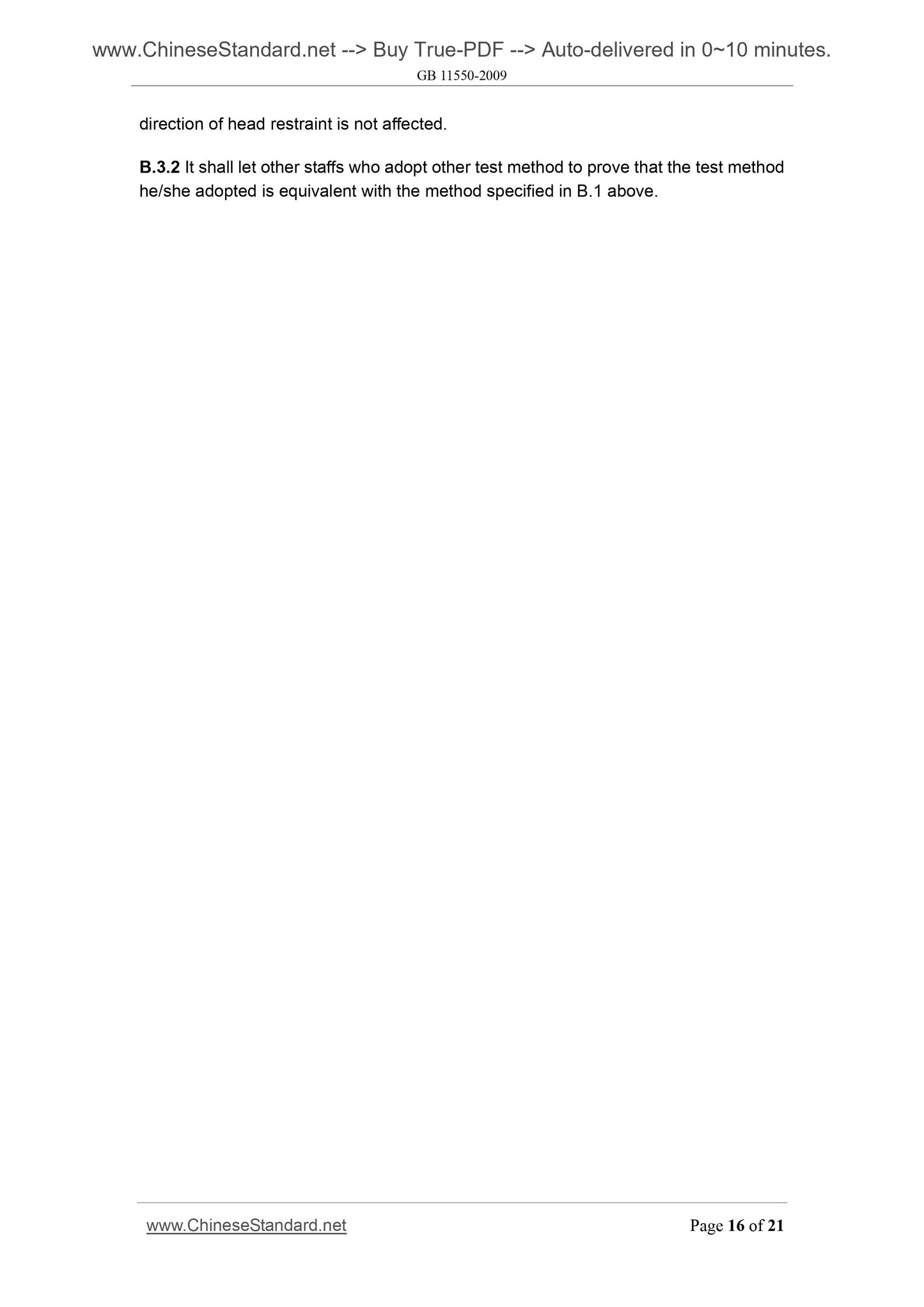1
/
su
9
PayPal, credit cards. Download editable-PDF & invoice in 1 second!
GB 11550-2009 English PDF (GB11550-2009)
GB 11550-2009 English PDF (GB11550-2009)
Prezzo di listino
$135.00 USD
Prezzo di listino
Prezzo scontato
$135.00 USD
Prezzo unitario
/
per
Spese di spedizione calcolate al check-out.
Impossibile caricare la disponibilità di ritiro
Delivery: 3 seconds. Download true-PDF + Invoice.
Get QUOTATION in 1-minute: Click GB 11550-2009
Historical versions: GB 11550-2009
Preview True-PDF (Reload/Scroll if blank)
GB 11550-2009: Strength requirement and test of automobile seats head restraints
GB 11550-2009
GB
ICS 43.040.60
T 26
National Standard of the People’s Republic of China
Replacing GB 11550-1995
Strength requirement and test of
automobile seats head restraints
ISSUED ON. SEPTEMBER 30, 2009
IMPLEMENTED ON. JANUARY 01, 2011
Issued by. General Administration of Quality Supervision, Inspection and
Quarantine;
Standardization Administration Committee.
Table of Contents
Foreword ... 3
1 Scope ... 5
2 Normative references ... 5
3 Terms and Definitions ... 6
4 Requirements ... 8
5 Test methods ... 10
Annex A ... 13
Annex B ... 14
Annex C ... 17
Annex D ... 19
Annex E ... 20
Foreword
All technical contents of this Standard are compulsory.
This Standard will replace GB 11550-1995 Motor vehicles - Seats head restraints -
Performance requirement and test methods.
This Standard modifies and adopts Economic Commission for Europe’s Regulations
ECE R25 (Version 1, 1999) Uniform Provisions Concerning the Approval of Head
Restraints (regardless whether it is integrated with seats) (English version).
This Standard has been redrafted according to ECE R25. Comparison schedule
between chapter numbering of this Standard and Regulations ECE R25 is listed in
Annex A.
Considering the situations of our country, when adopting ECE R25, there have been
some changes in this Standard.
The main technical differences BETWEEN this Standard AND ECE R25, and the
reasons are as follows.
- Delete Annex 3 “Procedure for Determining the ‘H’ Point and the Actual Torso
Angle for Seating Positions in Motor Vehicles” of ECE R25. In this Standard, the
contents involved with this aspect shall be executed by referring to the contents of
Annex C of newly issued national standard GB 11551-2003. This prevents the
errors in practical operation caused by difference of verbiage in standard drafting.
- Delete Chapter 3 Application of approval, Chapter 4 Markings, Chapter 5
Approval, Chapter 8 Conformity of production, Chapter 9 Penalties for
non-conformity of production, Chapter 10 Modification and extension of approval
of a type of head restraint, Chapter 11 Instructions, Chapter 12 Production
definitely discontinued, Chapter 13 Transitional provisions, Chapter 14 The
contents - Names and addresses of certification department and administrative
departments belong to “certification programs and certification mark”. The
reasons are caused by the form difference of standard system and legislative
system.
Main differences between this Standard and GB 11550-1995 include.
- Add general requirements of head restraints (4.1 of this version);
- Add requirements of head restraints surface curvature (4.2 of this version);
- Add requirements of head restraints clearance dimension (4.6.2.2 and 4.6.3 of
this version);
Strength requirement and test of
automobile seats head restraints
1 Scope
This Standard specifies terms and definitions, requirements and test method for
automobile seats head restraints.1
This Standard applies to seats head restraint of vehicles of categories M and N of
GB/T 15089-2001.
This Standard does not apply to head restraint of folding, side-facing or
rearward-facing seats.
2 Normative references
The following referenced documents are indispensable for the application of this
document. For dated references, subsequent amendments (corrigenda excluded) or
revisions of these publications do not apply. However, the parties who enter into
agreement based on this Standard are encouraged to investigate the possibility of
applying the latest edition of the standard. For undated references, the latest edition of
the referenced document (including any amendments) applies.
GB 11551-2003 The protection of the occupants in the event of a frontal collision
for passenger vehicle
GB 13057-2003 The strength of the seats and their anchorages of passenger
vehicles
GB 15083-2006 Strength requirement and test of automobile seats, their
anchorages and any head restraints
GB/T 15089-2001 Classification of power-driven vehicles and trailers
ISO 6487.1980 Measurement technology for collision test. Measurement
instrument
1 Head restraints of vehicle of category of M1 in compliance with GB 15083-2006 can be
regarded as to meet this Standard.
3.3
type of seat
Seats which share same dimension, framework or pad. The surface and color can be
different.
3.4
type of head restraint
Head restraints which share same dimension, framework or pad. The surface, color
and panel skin can be different.
3.5
reference point (H point)
Crossing point BETWEEN torso of three-dimensional H-point device representing
human body in relation to the theoretical pivot of thigh AND longitudinal vertical plane
of seat.
3.6
reference line
The line on the three-dimensional manikin illustrated in Figure C.1 of Attachment 1 of
Annex C of GB 11551-2003.
3.7
head line
A straight line passing through the centre of gravity of the head and through the joint
of the neck and the thorax. When the head is at rest, the head line is situated in the
extension of the reference line.
3.8
folding seat
An auxiliary seat intended for occasional use and normally folded.
3.9
adjustment system
The device by which the seat or its parts can be adjusted to a position suited to the
for the pressure produced by headform for test using, shall not exist rigid projections
which may cause injure.
4.4 The height of head restraints shall meet the following requirements.
4.4.1 Measure the height of head restraints as described in paragraph 5.2 below.
4.4.2 For head restraints not adjustable for height, the height of front seats shall not
be less than 800 mm; For other seats, the height shall not be less than 750 mm.
4.4.3 For head restraints adjustable for height.
4.4.3.1 The head restraint’s height measured at the highest adjustable position. For
the front seats, the values shall not be less than 800 mm; For other seats, the values
shall not be less than 750 mm.
4.4.3.2 There shall be no “use-position” in a height of less than 750 mm.
4.4.3.3 Except the front seats, other seats’ head restraints can be adjusted to a
position of which the height is less than 750 mm. However, occupants must be clearly
informed that this place is not the use-position of head restraints.
4.4.3.4 The front seats, if their head restraints can automatically return to the
use-position when the seat is occupied, can automatically lower the height to less
than 750 mm when the seat is not occupied.
4.4.4 To guarantee the adequate clearance BETWEEN the head restraint AND roof,
windows and any part of the vehicle structure, for the front seats, the size specified in
4.4.2 and 4.4.3.1 can be less than 800; for other seats, it can be less than 750mm.
However, the clearance shall not exceed 25 mm. For seats fitted with displacement
and/or adjustment systems, this shall apply to the seat. Furthermore, there shall not
have any “use-position” lower than 700 mm.
4.4.5 For the rear center seats or head restraints of seating positions, it may reduce
the height specified in 4.4.2 and 4.4.3.1. However, it shall not be less than 700 mm.
4.5 For head restraint installed with adjustable height, the use-part’s height of the
head restraints measured in 5.2 provisions shall not be less than 100 mm.
4.6 For head restraint not installed with adjustable height, the gap of the head restraint
and the seat-back ...
Get QUOTATION in 1-minute: Click GB 11550-2009
Historical versions: GB 11550-2009
Preview True-PDF (Reload/Scroll if blank)
GB 11550-2009: Strength requirement and test of automobile seats head restraints
GB 11550-2009
GB
ICS 43.040.60
T 26
National Standard of the People’s Republic of China
Replacing GB 11550-1995
Strength requirement and test of
automobile seats head restraints
ISSUED ON. SEPTEMBER 30, 2009
IMPLEMENTED ON. JANUARY 01, 2011
Issued by. General Administration of Quality Supervision, Inspection and
Quarantine;
Standardization Administration Committee.
Table of Contents
Foreword ... 3
1 Scope ... 5
2 Normative references ... 5
3 Terms and Definitions ... 6
4 Requirements ... 8
5 Test methods ... 10
Annex A ... 13
Annex B ... 14
Annex C ... 17
Annex D ... 19
Annex E ... 20
Foreword
All technical contents of this Standard are compulsory.
This Standard will replace GB 11550-1995 Motor vehicles - Seats head restraints -
Performance requirement and test methods.
This Standard modifies and adopts Economic Commission for Europe’s Regulations
ECE R25 (Version 1, 1999) Uniform Provisions Concerning the Approval of Head
Restraints (regardless whether it is integrated with seats) (English version).
This Standard has been redrafted according to ECE R25. Comparison schedule
between chapter numbering of this Standard and Regulations ECE R25 is listed in
Annex A.
Considering the situations of our country, when adopting ECE R25, there have been
some changes in this Standard.
The main technical differences BETWEEN this Standard AND ECE R25, and the
reasons are as follows.
- Delete Annex 3 “Procedure for Determining the ‘H’ Point and the Actual Torso
Angle for Seating Positions in Motor Vehicles” of ECE R25. In this Standard, the
contents involved with this aspect shall be executed by referring to the contents of
Annex C of newly issued national standard GB 11551-2003. This prevents the
errors in practical operation caused by difference of verbiage in standard drafting.
- Delete Chapter 3 Application of approval, Chapter 4 Markings, Chapter 5
Approval, Chapter 8 Conformity of production, Chapter 9 Penalties for
non-conformity of production, Chapter 10 Modification and extension of approval
of a type of head restraint, Chapter 11 Instructions, Chapter 12 Production
definitely discontinued, Chapter 13 Transitional provisions, Chapter 14 The
contents - Names and addresses of certification department and administrative
departments belong to “certification programs and certification mark”. The
reasons are caused by the form difference of standard system and legislative
system.
Main differences between this Standard and GB 11550-1995 include.
- Add general requirements of head restraints (4.1 of this version);
- Add requirements of head restraints surface curvature (4.2 of this version);
- Add requirements of head restraints clearance dimension (4.6.2.2 and 4.6.3 of
this version);
Strength requirement and test of
automobile seats head restraints
1 Scope
This Standard specifies terms and definitions, requirements and test method for
automobile seats head restraints.1
This Standard applies to seats head restraint of vehicles of categories M and N of
GB/T 15089-2001.
This Standard does not apply to head restraint of folding, side-facing or
rearward-facing seats.
2 Normative references
The following referenced documents are indispensable for the application of this
document. For dated references, subsequent amendments (corrigenda excluded) or
revisions of these publications do not apply. However, the parties who enter into
agreement based on this Standard are encouraged to investigate the possibility of
applying the latest edition of the standard. For undated references, the latest edition of
the referenced document (including any amendments) applies.
GB 11551-2003 The protection of the occupants in the event of a frontal collision
for passenger vehicle
GB 13057-2003 The strength of the seats and their anchorages of passenger
vehicles
GB 15083-2006 Strength requirement and test of automobile seats, their
anchorages and any head restraints
GB/T 15089-2001 Classification of power-driven vehicles and trailers
ISO 6487.1980 Measurement technology for collision test. Measurement
instrument
1 Head restraints of vehicle of category of M1 in compliance with GB 15083-2006 can be
regarded as to meet this Standard.
3.3
type of seat
Seats which share same dimension, framework or pad. The surface and color can be
different.
3.4
type of head restraint
Head restraints which share same dimension, framework or pad. The surface, color
and panel skin can be different.
3.5
reference point (H point)
Crossing point BETWEEN torso of three-dimensional H-point device representing
human body in relation to the theoretical pivot of thigh AND longitudinal vertical plane
of seat.
3.6
reference line
The line on the three-dimensional manikin illustrated in Figure C.1 of Attachment 1 of
Annex C of GB 11551-2003.
3.7
head line
A straight line passing through the centre of gravity of the head and through the joint
of the neck and the thorax. When the head is at rest, the head line is situated in the
extension of the reference line.
3.8
folding seat
An auxiliary seat intended for occasional use and normally folded.
3.9
adjustment system
The device by which the seat or its parts can be adjusted to a position suited to the
for the pressure produced by headform for test using, shall not exist rigid projections
which may cause injure.
4.4 The height of head restraints shall meet the following requirements.
4.4.1 Measure the height of head restraints as described in paragraph 5.2 below.
4.4.2 For head restraints not adjustable for height, the height of front seats shall not
be less than 800 mm; For other seats, the height shall not be less than 750 mm.
4.4.3 For head restraints adjustable for height.
4.4.3.1 The head restraint’s height measured at the highest adjustable position. For
the front seats, the values shall not be less than 800 mm; For other seats, the values
shall not be less than 750 mm.
4.4.3.2 There shall be no “use-position” in a height of less than 750 mm.
4.4.3.3 Except the front seats, other seats’ head restraints can be adjusted to a
position of which the height is less than 750 mm. However, occupants must be clearly
informed that this place is not the use-position of head restraints.
4.4.3.4 The front seats, if their head restraints can automatically return to the
use-position when the seat is occupied, can automatically lower the height to less
than 750 mm when the seat is not occupied.
4.4.4 To guarantee the adequate clearance BETWEEN the head restraint AND roof,
windows and any part of the vehicle structure, for the front seats, the size specified in
4.4.2 and 4.4.3.1 can be less than 800; for other seats, it can be less than 750mm.
However, the clearance shall not exceed 25 mm. For seats fitted with displacement
and/or adjustment systems, this shall apply to the seat. Furthermore, there shall not
have any “use-position” lower than 700 mm.
4.4.5 For the rear center seats or head restraints of seating positions, it may reduce
the height specified in 4.4.2 and 4.4.3.1. However, it shall not be less than 700 mm.
4.5 For head restraint installed with adjustable height, the use-part’s height of the
head restraints measured in 5.2 provisions shall not be less than 100 mm.
4.6 For head restraint not installed with adjustable height, the gap of the head restraint
and the seat-back ...
Share
